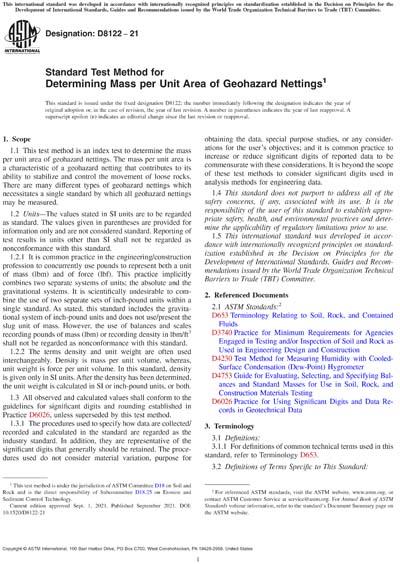Most recent
ASTM D8122-21
Standard Test Method for Determining Mass per Unit Area of Geohazard Nettings
1.1This test method is an index test to determine the mass per unit area of geohazard nettings. The mass per unit area is a characteristic of a geohazard netting that contributes to its ability to stabilize and control the movement of loose rocks. There are many different types of geohazard nettings which necessitates a single standard by which all geohazard nettings may be measured.
1.2Units - The values stated in SI units are to be regarded as standard. The values given in parentheses are provided for information only and are not considered standard. Reporting of test results in units other than SI shall not be regarded as nonconformance with this standard.
1.2.1It is common practice in the engineering/construction profession to concurrently use pounds to represent both a unit of mass (lbm) and of force (lbf). This practice implicitly combines two separate systems of units; the absolute and the gravitational systems. It is scientifically undesirable to combine the use of two separate sets of inch-pound units within a single standard. As stated, this standard includes the gravitational system of inch-pound units and does not use/present the slug unit of mass. However, the use of balances and scales recording pounds of mass (lbm) or recording density in lbm/ft3 shall not be regarded as nonconformance with this standard.
1.2.2The terms density and unit weight are often used interchangeably. Density is mass per unit volume, whereas, unit weight is force per unit volume. In this standard, density is given only in SI units. After the density has been determined, the unit weight is calculated in SI or inch-pound units, or both.
1.3All observed and calculated values shall conform to the guidelines for significant digits and rounding established in Practice D6026, unless superseded by this test method.
1.3.1The procedures used to specify how data are collected/recorded and calculated in the standard are regarded as the industry standard. In addition, they are representative of the significant digits that generally should be retained. The procedures used do not consider material variation, purpose for obtaining the data, special purpose studies, or any considerations for the user's objectives; and it is common practice to increase or reduce significant digits of reported data to be commensurate with these considerations. It is beyond the scope of these test methods to consider significant digits used in analysis methods for engineering data.
1.4This standard does not purport to address all of the safety concerns, if any, associated with its use. It is the responsibility of the user of this standard to establish appropriate safety, health, and environmental practices and determine the applicability of regulatory limitations prior to use.
1.5This international standard was developed in accordance with internationally recognized principles on standardization established in the Decision on Principles for the Development of International Standards, Guides and Recommendations issued by the World Trade Organization Technical Barriers to Trade (TBT) Committee.
Content Provider
ASTM International [astm]






